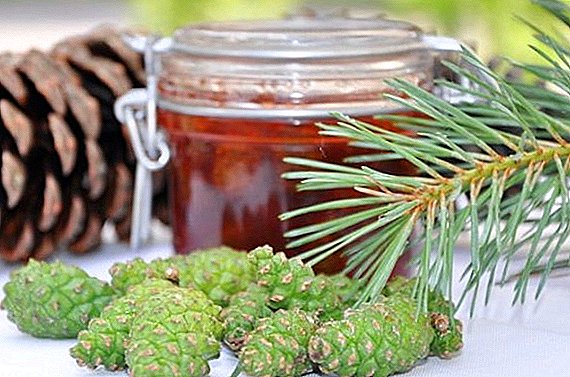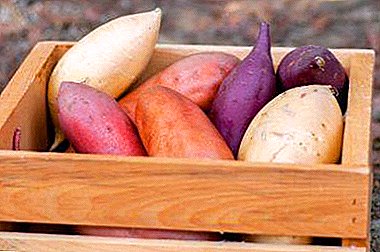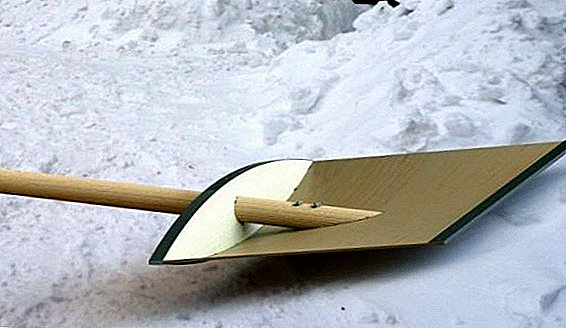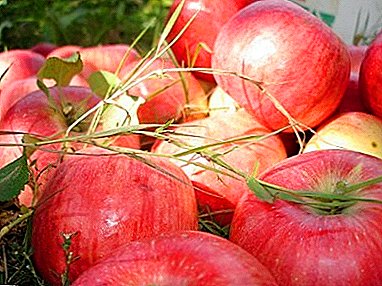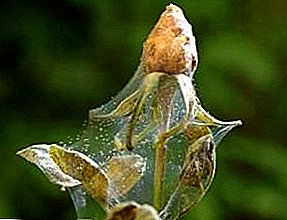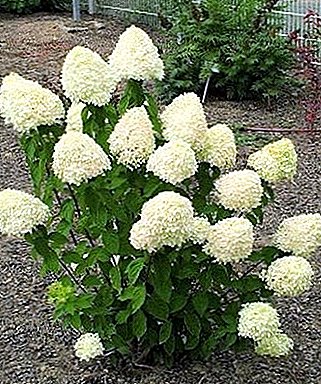
For many years, hydrangea is considered one of the most delightful decorations of a country garden. It looks very harmonious. High bushes with carved leaves, big hats of flowers of various delicate colors will not leave anyone indifferent.
Many gardeners will agree that hydrangea loves constant attention and care. It is not difficult to care for her, but in the process of growing you may encounter with a number of problems.
The flower is endowed with good immunity, but improper care and the vagaries of nature can provoke the occurrence diseases. It is very important to recognize the problem in time to provide timely assistance.
Leaf disease
Take the leading number among all diseases.
Why do the hydrangea leaves turn yellow?
- Yellowing of the foliage may indicate an overabundance of moisture. Although hydrangea loves frequent and abundant watering, with excessive accumulation of water, it loses its appeal.
- Pay attention to the acidity of the soil. If it is reduced, you can add a few drops of lemon juice to one liter of water during watering. The procedure is repeated several times.
- Protect the bush from drafts, hypothermia, sudden changes in temperature.
- Do not plant a flower in open sunny areas. He will be comfortable in the partial shade of large fruit trees or near spreading shrubs. If it is on the sunny side, try to create ambient lighting conditions.
- Yellowing of the foliage can be with a lack of nutrients. Regularly make feeding.
- Oslook at the leaves. If they appear a grayish bloom in the form of spots, powdery mildew infection is possible. Insecticide treatment will be required.

The hydrangea leaves dry, what to do?
- Lack of moisture, especially in arid summer.
- Dry air This is often encountered when grown in closed or half-open greenhouses. If possible, it is recommended to ventilate the greenhouse, install a humidifier, spray the air.
- Sometimes the tips of the leaves begin to dry after an improper transplant, during which the roots were damaged. Even if you adhere to the rules, no one is immune from a random error. You have to be patient and get to work. Every 10 days will require treatment with zircon. Up to 2 months may be required to restore health and strength.
- Lack of nutrients also affects health, especially during the formation of inflorescences and flowering. Fertilizer should be applied at least once every 7-9 days.

Why blacken hydrangea leaves?
For a start, a gardener needs to understand whether he has a weak or dry blackening. In each case, there are reasons and ways to improve the plant.
How boRoast with dry blackening?
In the case of dry blackening, large brownish spots are formed along the edges of the leaves, they become dry and fade. The reasons:
- Sunburn. Protect the bushes from direct sunlight. This applies both when grown in a greenhouse and in an open area.
- Overly hard water for irrigation. Gardeners often take cold water from the column. But in many areas it contains lime and other impurities. Be sure to defend it before watering. Put large tubs on the plot and fill them in the morning or evening. It is better to be placed on a sunny plot so that the water could warm up during the day.
How to deal with sluggish (wet) blackening?
It is not difficult to distinguish it by dark and limp leaves. The reasons:
- Excessive and abundant moisture.
- Drafts, sudden changes in temperature, too cold summer. In the latter case, you can protect the root system with a layer of mulch.
- Pay attention to the composition of the earth. Plant a flower in a loose, light, nutritious soil. Heavy soil retains moisture, inhibits breathing and nutrition.

Chlorosis
It occurs with iron deficiency. It is characterized by impaired chlorophyll formation. The plates turn yellow, and the streaks remain green. Iron may not be enough in the soil or the flower itself, for physiological reasons, has lost the ability to absorb the mineral.
Signs of chlorosis can be different: reducing the size of leaves and their color, twisting the plate, the deformation of the buds, the drying of the shoots.
Control and prevention measures:
- Pay attention to the features of the soil. It should be nutritious, good to pass oxygen to the roots. Water regularly with acidified water to maintain proper soil balance.
- If the disease began to develop, feed the bushes with iron preparations (in chelate form): Ferovit, Antichlorosis and others. Iron chelate can be prepared at home. To do this, in one liter of water dilute 4 grams of citric acid and add 2 grams of iron sulphate. The solution can be used for irrigation and spraying. By the way, iron chelate will act faster if you make it on the sheet!

Septoria
A disease in which a dark-brown spot 2-6 mm in diameter appears on the leaves (septorium spotting). The causative agent is Septoria. Affected leaves gradually turn yellow, die and fall off. As a result, the plant can completely lose leaves. With the spread of the disease, spots also appear on the stalks and young shoots.
How to deal with septoriosis?
- Fallen leaves need to be collected and destroyed in time to prevent the spread of the disease on the site.
- Cut off the affected shoots with the capture of the healthy part. Place the cuts to process the garden broth.
- In the spring, treatment with a Bordeaux liquid solution, as well as chemicals - Ridomit Gold, Profit, is required.
- If azalea is grown in a greenhouse, monitor the humidity of the air.

Rust on flowers
It is a fungal disease, during which a rusty hue forms on the flowers, leaves and shoots. May be due to excessive planting density, an excess of nitrogen in the ground.
Fighting Rust Garden Hydrangea
Copper oxychloride treatment is required (40 grams of the drug is diluted in 10 liters of water). Some gardeners use Bordeaux liquid, but it can leave marks. You can purchase drugs: Ordan, Topaz or Falcon.
Pest control
Garden hydrangea does not rarely become the "target" of various pests. It is important to recognize in time the beginning of a lesion and take measures for recovery, otherwise the flower will begin to wither.
Common pests

- Downy mildew. You can recognize it by oily stains on the surface of the leaves. Over time, they spread, turn yellow, acquire a dark shade. On the underside of leaves and young shoots a yellowish bloom forms. Powdery dew often occurs when grown in greenhouse conditions, at high humidity and air temperature of 17-20 degrees.
To get rid of the pest, you need to treat the soap-copper mixture, prepared from 150 grams of green soap, 15 grams of copper sulfate and 10 liters of water.
- Downy mildew. You can recognize it by oily stains on the surface of the leaves. Over time, they spread, turn yellow, acquire a dark shade. On the underside of leaves and young shoots a yellowish bloom forms. Powdery dew often occurs when grown in greenhouse conditions, at high humidity and air temperature of 17-20 degrees.

- Spider Tick - settles on the lower sides of the leaves, covering them with a web of brown shade. Then they become marble in color, dry up and fall off. A spider mite is a treacherous enemy. With high temperature (27-30 degrees) and low humidity, it spreads in just 5-7 days.
You can fight ticks with thiophos.
- Spider Tick - settles on the lower sides of the leaves, covering them with a web of brown shade. Then they become marble in color, dry up and fall off. A spider mite is a treacherous enemy. With high temperature (27-30 degrees) and low humidity, it spreads in just 5-7 days.

- Green leaf aphid - no less dangerous pest. It sucks the juice, leaves a sugary unpleasant discharge, in which fungi are formed. It spreads quickly, the leaves turn yellow and crumble. Settled on the bottom of the sheet.
Fighting aphids can be insecticidal.
- Green leaf aphid - no less dangerous pest. It sucks the juice, leaves a sugary unpleasant discharge, in which fungi are formed. It spreads quickly, the leaves turn yellow and crumble. Settled on the bottom of the sheet.

- Slugs - attack in conditions of too thick and frequent landing. They cause harm by eating the leaves. You can fight them with molluscicide (granular preparation). It is scattered near the bushes on the surface of the earth.
How to reanimate the hydrangea after winter?
If the flowers were properly prepared before the onset of cold weather (hidden under cover), there will be no problems. With the onset of spring, the flowers will come to life and will delight the summer with new blooms. And what if the flower remained in the winter without shelter? Return to the old form will be difficult. But this task is quite feasible.
- Treatment is required to protect against fungal diseases. bordeaux mixture or copper solution.
- The affected foliage and twigs are removed and after two weeks the treatment is repeated.
- Pay attention to the ground. Acidify it weak lemon solution.
- Be sure to tidy up the appearance of the plant, remove frozen, dry twigs, to feed. This year it will not bloom, but if you take all the necessary measures and properly prepare for the next wintering, in a year it will gain strength and blossom again.
Hortensia is a charming flower that loves constant attention and care. Take care of him correctly and he will be the main decoration of your summer country garden.
A photo
More photos on hydrangea garden diseases see below:






